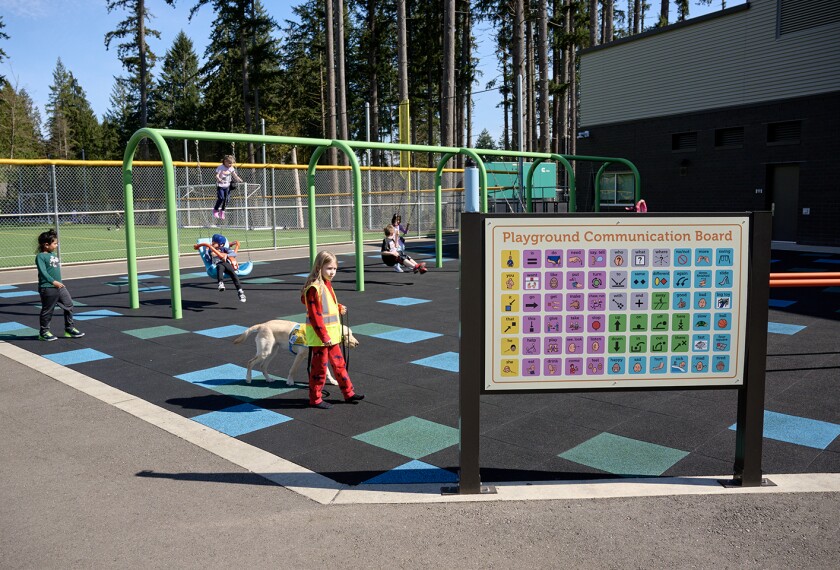More youths with disabilities are successfully making the transition from school to higher education, jobs, and adult responsibilities than they did in the late 1980s, according to a federally financed study that has tracked thousands of secondary school students with disabilities over time.
The percentage of students completing high school rose from 53.5 percent in 1987 to 70.3 percent in 2003, according to the report, released by the U.S. Department of Education late last month. During the same period, the rate at which students enrolled in any type of postsecondary education rose from 14.6 percent to 31.9 percent.
Read “Changes Over Time in the Early Postschool Outcomes of Youth With Disabilities” from the National Longitudinal Transition Study-2.
Similar positive gains appeared in employment; participation in core-academic courses such as mathematics, science, social studies, and foreign languages; and enrollment in a grade appropriate to the student’s age, among other areas.
Federal officials said the gains reflect real achievements in reaching out to teenagers with disabilities.
“These accomplishments show the benefits of accountability and high academic standards among all students, including those with disabilities,” U.S. Secretary of Education Margaret Spellings said in a statement.
In a later interview, Troy R. Justesen, the acting director of the department’s office of special education programs, said, “We can debate policy reform all we want, but it’s finally working. It’s starting to show some dramatic increases.” The office paid for the study as part of a national assessment of the 1997 Individuals with Disabilities Education Act.
Some Still Struggling
At the same time, the study highlights areas of continuing concern. Black and Hispanic youths lagged significantly behind their white peers in such areas as independent living and postsecondary attendance and completion rates. In addition, no real increase in earnings among young people with disabilities took place over a 16-year period, after adjusting for inflation. In 1987, youths with disabilities earned about $7.80 an hour; in 2003, the figure was $7.30.
On another negative note, more adolescents with disabilities reported they had been subjected to serious school discipline, arrest, or firing from a job in 2003 compared with 1987.
See the related item,
Those with emotional disturbances and other health impairments also lagged behind students in other disability groups in terms of achievement.
Mr. Justesen suggested that effective interventions for students with emotional disturbances be made schoolwide.
For children with emotional disturbances, “administrators have to learn how to modify the entire environment of a school,” he said.
Other disabilities, such as vision, hearing, and other physical impairments, are relatively easier to address, he said. The report shows that youths with such conditions generally had the highest rates of college attendance among those with disabilities.
The National Longitudinal Transitions Study-2, referred to as NLTS2, is the second research undertaking of its type financed by the Department of Education. The first study documented the experience of thousands of youngsters with disabilities from the late 1980s through the early 1990s. The newer study began in 2001 and will follow a group of about 12,000 youths every other year through 2009. A Menlo Park, Calif.-based research institute, SRI International, is conducting both longitudinal studies. The July report drew on data from students who were ages 15 to 19 at the time of the interviews. Most were male and had learning disabilities or emotional disturbances.
Mr. Justesen said information gathered through the studies is available to other researchers for their own analyses.
More Support Needed
“This provides the scientific foundation and data that everyone is looking for,” said Deborah Leuchovius, who coordinates a project that helps young people with disabilities make the transition to adulthood for the Minneapolis-based Parent Advocacy Coalition for Educational Rights. “It confirms what transition professionals already know and what families are already experiencing.”
But, as the report notes, there’s still plenty of room for improvement in preventing dropouts and ensuring success for students with emotional and behavioral needs, Ms. Leuchovius said.
Carole E. Walsh, the transition coordinator for six small school districts in northwest Colorado, agreed that transition into postschool life for special education students has improved since she first started teaching in 1974. She works with colleges, vocational schools, and other groups that help students with disabilities make a seamless transition from school to community life.
“It’s more of a ‘hand-off’ situation,” said Ms. Walsh, who is a member of a group of special education professionals appointed by the National Education Association to assist other teachers in learning about special education topics. “[Students] are already connected with what that next step is going to be.”





